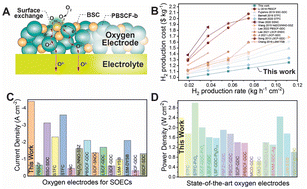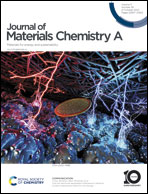Boosting the performance of reversible solid oxide electrochemical cells with a novel hybrid oxygen electrode, Pr1.39Ba0.14Sr0.53Co1.48Fe0.76O6−δ-Ba0.66Sr0.34CoO3−δ†
Abstract
Solid oxide electrochemical cells (SOECs) stand out as a highly promising clean energy technology that offers several benefits, showing significant potential to play a pivotal role in the transition towards a sustainable and low-carbon energy future. SOECs can efficiently convert the chemical energy stored in fuels to electricity in fuel cell mode, and produce various chemicals from abundant feedstocks (e.g., CO2, H2O) and intermittent solar/wind-based renewable electricity. Despite extensive efforts that have been devoted to designing novel materials and optimizing SOEC manufacturing processes, aiming to achieve enhanced energy efficiency, the current SOECs still suffer from poor performance, which is mainly due to the sluggish oxygen reduction reaction (ORR) and oxygen evolution reaction (OER) kinetics. To address this challenge, in this work, we have successfully designed an in situ formed hybrid oxygen electrode material (Pr1.39Ba0.14Sr0.53Co1.48Fe0.76O6−δ-Ba0.66Sr0.34CoO3−δ), which significantly improves the surface oxygen exchange coefficient and bulk oxygen-ion diffusion coefficient, enhancing the OER and ORR electrocatalytic activities. The SOECs equipped with this newly developed oxygen electrode achieved exceptional performance for power generation using both hydrogen and propane as the fuels. At 750 °C, a peak power density of 2.4 W cm−2 was obtained with H2 as the fuel. Additionally, the SOECs attain unprecedented performance in steam electrolysis mode. A current density of 4.4 A cm−2 was achieved at 1.3 V and 750 °C, which represents the highest performance among all yttria-stabilized zirconia (YSZ) electrolyte-based SOECs. The SOECs also deliver remarkable stability during the accelerated stability testing, highlighting the great potential of Pr1.39Ba0.14Sr0.53Co1.48Fe0.76O6−δ-Ba0.66Sr0.34CoO3−δ as a high-performance oxygen electrode for next generation SOECs.

- This article is part of the themed collection: #MyFirstJMCA


 Please wait while we load your content...
Please wait while we load your content...